Just a quick note that the TV talk show "Mirror" on Channel i, hosted by my better half Sonia, will air today at 6:20PM BST (London 1:20pm, NY 8:20am, Dallas 7:20am, San Francisco 5:20am). There will be a re-broadcast later in the week - I will post the time as soon as I find out.
The show features various ambassadors in Bangladesh and their experiences here. This week's guest is the French Ambassador.
Monday, May 29, 2006
Pretty Cambridge (UK)
Sunday, May 28, 2006
Interesting People in London
During my visit to London, I "ran into" some interesting people.
I was walking by a bookstore on the way to a meeting, when I saw a sign saying Pele, the legendary footballer, would be book-signing at 6PM Thursday. It took me a couple of moments to realize it was Thursday and very close to 6. I am no closet Paparazzi, but I was not about to pass up on a Pele sighting.
Here is the picture I got (you can see I failed the Paparazzi test :-)). But it was great to see this legend:
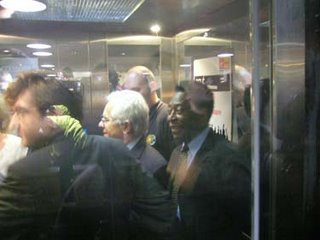
Weirder, here was a guy in the crowd who looked exactly like Scott McNealy!

Another time our delegation was invited to a dinner. The guest speaker was the Queen's son, Andrew, the Duke of York (Fergie's ex):

This was the place setting for the dinner. Over the top, but hey it is royalty!

In his speech, Andrew went to bat for the British IT industry, urging the invited foreign businessmen to do business with UK companies. Perhaps more Bangladeshi leaders can do the same for the IT industry here?
I was walking by a bookstore on the way to a meeting, when I saw a sign saying Pele, the legendary footballer, would be book-signing at 6PM Thursday. It took me a couple of moments to realize it was Thursday and very close to 6. I am no closet Paparazzi, but I was not about to pass up on a Pele sighting.
Here is the picture I got (you can see I failed the Paparazzi test :-)). But it was great to see this legend:

Weirder, here was a guy in the crowd who looked exactly like Scott McNealy!

Another time our delegation was invited to a dinner. The guest speaker was the Queen's son, Andrew, the Duke of York (Fergie's ex):

This was the place setting for the dinner. Over the top, but hey it is royalty!

In his speech, Andrew went to bat for the British IT industry, urging the invited foreign businessmen to do business with UK companies. Perhaps more Bangladeshi leaders can do the same for the IT industry here?
Bangladeshis in London
I lived in London from 1975 to 1977. Those were dark days for Bangladeshis (indeed, all immigrants) in London. Racism was rampant and economically the Bangladeshis inhabited the bottom of the food chain.
Two weeks ago I visited London as part of a business delegation. I had some meetings in Brick Lane and got to re-visit some of the "slums" I remembered from earlier days. Boy have things changed!
Bangladeshis (specially 2nd and 3rd generation) are now an upwardly-mobile group in the UK. Brick Lane thrives with rushing young people running their own businesses.
Not only do Bangladeshis own over 20000 restaurants in the UK, they sometimes co-opt other cuisine and give it a Bangladeshi taste. Eg, "Perfect Fried Chicken", a Bangladeshi-owned chain, takes the traditional Doner Kabab (Gyros) and fries it with chilis and Bengali spices to turn out a Bangladeshi Doner Kabab. I thought a good Doner Kabab could not be improved but these guys proved me wrong.
Bangladeshis hold many high-profile positions in the UK. For example, Irene Khan, the chief of Amnesty International, is from Bangladesh. So is the new mayor of Tower Hamlet Borough. The Qureshi family is probably a record-breaker in having three elected officials, called "Councillors", in London. And of course, Anwar Choudhury, the British High Commissioner in Dhaka.
In the (rather fat) book "Probashir Katha", Nurul Islam chronicles how the Bangladeshis - most of them from Sylhet - arrived in the UK. For example, Bangladeshi sailors fought alongside the British in the First world war and are mentioned in War Memorials in London. During the 1970s, several Bangladeshis were killed in racist violence.
But the persistence of this community - particularly in educating their younger generations - has paid off. I congratulate them on their success.
A signpost on Tower Bridge pointing to Banglatown:

A park in memory of Altab Ali, killed by racists in 1978:
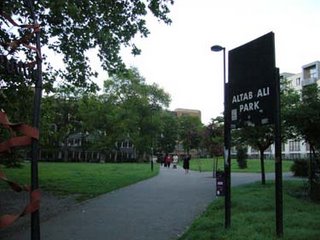
Two weeks ago I visited London as part of a business delegation. I had some meetings in Brick Lane and got to re-visit some of the "slums" I remembered from earlier days. Boy have things changed!
Bangladeshis (specially 2nd and 3rd generation) are now an upwardly-mobile group in the UK. Brick Lane thrives with rushing young people running their own businesses.
Not only do Bangladeshis own over 20000 restaurants in the UK, they sometimes co-opt other cuisine and give it a Bangladeshi taste. Eg, "Perfect Fried Chicken", a Bangladeshi-owned chain, takes the traditional Doner Kabab (Gyros) and fries it with chilis and Bengali spices to turn out a Bangladeshi Doner Kabab. I thought a good Doner Kabab could not be improved but these guys proved me wrong.
Bangladeshis hold many high-profile positions in the UK. For example, Irene Khan, the chief of Amnesty International, is from Bangladesh. So is the new mayor of Tower Hamlet Borough. The Qureshi family is probably a record-breaker in having three elected officials, called "Councillors", in London. And of course, Anwar Choudhury, the British High Commissioner in Dhaka.
In the (rather fat) book "Probashir Katha", Nurul Islam chronicles how the Bangladeshis - most of them from Sylhet - arrived in the UK. For example, Bangladeshi sailors fought alongside the British in the First world war and are mentioned in War Memorials in London. During the 1970s, several Bangladeshis were killed in racist violence.
But the persistence of this community - particularly in educating their younger generations - has paid off. I congratulate them on their success.
A signpost on Tower Bridge pointing to Banglatown:

A park in memory of Altab Ali, killed by racists in 1978:

Friday, May 26, 2006
Center of Excellence for IT in Bangladesh
I have been thinking about this idea for a while, and wanted to write down my thoughts.
Why?
----
One way that Bangladesh can attain higher success in IT is to achieve excellence in smaller sub-areas of IT. Currently the IT industry in Bangladesh is trying to do too many things with too few skilled people. If we want to achieve success on a broad front of IT, we need tens of thousands of quality IT graduates every year. This is not realistic.
Therefore, we need to pick our battles carefully. Our kids are very intelligent. If we can focus them more in one or two areas, we can establish Bangladesh as a dominant player in certain subareas of IT.
For example, certain Eastern European countries are well-known as developers of Software Tools such as compilers, debuggers etc. The Philippines has established a reputation in animation. Many ATM-banking software packages come from Russian companies. Certain parts of Canada are well known for digital video expertise. And so on.
Once we establish technical excellence in an area, this will lead to more people being trained in this area and one hopes the critical mass needed for take-off will be created.
What Will it do?
----------------
In each Center of Excellence, a number of students (15? 20?)will work with academic and industry people and build software of industrial quality. They will learn to work as teams, use the tools and technologies needed, and under the guidance of a project lead, execute a project. Once the software is done it will be distributed as open-source software.
Why Will it Work?
-----------------
The emergence of open source software is one of the biggest reasons why CoE will work. This kind of software gives a head-start to anyone wanting to build a software project in many areas.
Another reason why it will work is that many bright young students are eager to sink their teeth into knotty, cutting-edge problems. Many CS/CSE students graduate without having built any real-world software because they were so busy learning the fundamentals. They are very eager to learn how to build "real" software.
Finally it will work because it will improve the employment prospects of the students.
Who Will Fund it?
-----------------
Such a Center will need to be heavily subsidized, with the understanding that perhaps, after 3 or more years, some revenue-generating work may be created. However, that should not be the goal of the CoE.
We cannot expect the students to pay high tuitions, although some fees must be charged so that students feel compelled to attend to get their money's worth.
What are the Subareas?
----------------------
Obviously the subareas must improve the employment prospects of the students. At the same time, they must be technically challenging. And they must be growth areas, globally.
Some possible areas are: Web 2.0 technologies, animation, database tuning, GIS, etc.
Is a CoE the Same as a "S/W Finishing School?"
--------------------------------------------
Not really. The difference is in the focus. While both want to make software engineers out of CS/CSE graduates, a CoE also wants to build up a critical mass of skills in a certain technological area so we can compete with the rest of the world in that area.
Who Will Run it?
----------------
A CoE must be run jointly by one or more universities and the IT industry. The former will contribute ideas, students, and skilled resources. The latter will contribute engineering discipline, solving tough engineering problems, and mentoring. Management can be done jointly.
Why?
----
One way that Bangladesh can attain higher success in IT is to achieve excellence in smaller sub-areas of IT. Currently the IT industry in Bangladesh is trying to do too many things with too few skilled people. If we want to achieve success on a broad front of IT, we need tens of thousands of quality IT graduates every year. This is not realistic.
Therefore, we need to pick our battles carefully. Our kids are very intelligent. If we can focus them more in one or two areas, we can establish Bangladesh as a dominant player in certain subareas of IT.
For example, certain Eastern European countries are well-known as developers of Software Tools such as compilers, debuggers etc. The Philippines has established a reputation in animation. Many ATM-banking software packages come from Russian companies. Certain parts of Canada are well known for digital video expertise. And so on.
Once we establish technical excellence in an area, this will lead to more people being trained in this area and one hopes the critical mass needed for take-off will be created.
What Will it do?
----------------
In each Center of Excellence, a number of students (15? 20?)will work with academic and industry people and build software of industrial quality. They will learn to work as teams, use the tools and technologies needed, and under the guidance of a project lead, execute a project. Once the software is done it will be distributed as open-source software.
Why Will it Work?
-----------------
The emergence of open source software is one of the biggest reasons why CoE will work. This kind of software gives a head-start to anyone wanting to build a software project in many areas.
Another reason why it will work is that many bright young students are eager to sink their teeth into knotty, cutting-edge problems. Many CS/CSE students graduate without having built any real-world software because they were so busy learning the fundamentals. They are very eager to learn how to build "real" software.
Finally it will work because it will improve the employment prospects of the students.
Who Will Fund it?
-----------------
Such a Center will need to be heavily subsidized, with the understanding that perhaps, after 3 or more years, some revenue-generating work may be created. However, that should not be the goal of the CoE.
We cannot expect the students to pay high tuitions, although some fees must be charged so that students feel compelled to attend to get their money's worth.
What are the Subareas?
----------------------
Obviously the subareas must improve the employment prospects of the students. At the same time, they must be technically challenging. And they must be growth areas, globally.
Some possible areas are: Web 2.0 technologies, animation, database tuning, GIS, etc.
Is a CoE the Same as a "S/W Finishing School?"
--------------------------------------------
Not really. The difference is in the focus. While both want to make software engineers out of CS/CSE graduates, a CoE also wants to build up a critical mass of skills in a certain technological area so we can compete with the rest of the world in that area.
Who Will Run it?
----------------
A CoE must be run jointly by one or more universities and the IT industry. The former will contribute ideas, students, and skilled resources. The latter will contribute engineering discipline, solving tough engineering problems, and mentoring. Management can be done jointly.
Barriers to Venture Capital
Venture Capital is a powerful and effective way for doing big and interesting things in cutting-edge technologies. VC enables entrepreneurs to pursue their dreams by providing funds for their projects in exchange for a share of the business they are creating. VC have enabled many success stories in Silicon Valley (eg, Sun, Google, Cisco) as well as in other parts of the world.
A VC investment is not a loan. If you are an investor, risks in funding a VC project are very high. If the venture fails - happens 90% of the time - you lose your investment. But gains are also high, with 100x returns not uncommo in a successful venture.
The other day I was talking to someone from the British govt who has worked in Bd for several years on promoting different types of businesses. When I found out that he had an investment banking background, I asked him what were the barriers to creating a Venture Capital friendly environment here.
He mentioned two top items: no "exit strategy", and the lack of minority rights.
"Exit strategy" is how a VC investor realizes their gains in a successful venture. In the West, when a VC-funded company turns into a successful business, it is either floated (IPO) in the share market (in which case the investor makes a ton of money from selling their share of the company), or it is sold to a bigger company (in which case usually the investor's share also becomes a lot of money.) In Bangladesh, this person pointed out, neither is a viable option. The stock market is not vibrant, and there is no practice of buying out companies.
Minority rights was unfamiliar to me. So he explained it. VC investors are usually minority shareholders in a company (ie, they own < 50%). In the West, with this much ownership, they still have lots of rights and power within the company. However, in Bd, in a company boardroom, the majority shareholder has much greater power over the rights of the minority shareholder.
I plan to dig in more. I have heard lots of businessmen in Bd are sitting on tons of money, and we need to enable them to profitably put this equity back into the economy. A VC culture would be a boon to our IT business and help create an economy based on higher value goods and services.
A VC investment is not a loan. If you are an investor, risks in funding a VC project are very high. If the venture fails - happens 90% of the time - you lose your investment. But gains are also high, with 100x returns not uncommo in a successful venture.
The other day I was talking to someone from the British govt who has worked in Bd for several years on promoting different types of businesses. When I found out that he had an investment banking background, I asked him what were the barriers to creating a Venture Capital friendly environment here.
He mentioned two top items: no "exit strategy", and the lack of minority rights.
"Exit strategy" is how a VC investor realizes their gains in a successful venture. In the West, when a VC-funded company turns into a successful business, it is either floated (IPO) in the share market (in which case the investor makes a ton of money from selling their share of the company), or it is sold to a bigger company (in which case usually the investor's share also becomes a lot of money.) In Bangladesh, this person pointed out, neither is a viable option. The stock market is not vibrant, and there is no practice of buying out companies.
Minority rights was unfamiliar to me. So he explained it. VC investors are usually minority shareholders in a company (ie, they own < 50%). In the West, with this much ownership, they still have lots of rights and power within the company. However, in Bd, in a company boardroom, the majority shareholder has much greater power over the rights of the minority shareholder.
I plan to dig in more. I have heard lots of businessmen in Bd are sitting on tons of money, and we need to enable them to profitably put this equity back into the economy. A VC culture would be a boon to our IT business and help create an economy based on higher value goods and services.
Wednesday, May 10, 2006
Driving in Dhaka
During my first few weeks in Dhaka, I was constantly stressed by the driving. I mostly relied on a driver, but was worried he was going to hit someone or something. Amazingly, nowadays I am relaxed in the car.
Some unwritten rules I have gathered (remember, you drive on the left here):
If you are at an intersection and want to turn right, it is best to be on the leftmost lane and swerve all the way to the right at the last possible moment. This helps keep everyone awake and provides free brake-check for parties on the right.
Rickshawallahs will not brake unless faced with a situation where the cost of not braking is significantly higher than the cost of braking. One such situation is a policeman with a big stick. Impending collision with a speeding car does not constitute a reason for a rickshawallah to brake. After all, it is easy for the car driver to brake and resume, but it is much harder for the rickshawallah to do that.
If you are a CNG driver, then the amount of arrogance you show while saying "No" to a prospective passenger's trip request should be directly proportional to how exhausted/sweaty/pitiful the passenger looks.
If you are a bus driver, nothing will dare get in your way. Do as you please.
Honking is an act of courtesy. You should honk whenever there is the remotest chance that the person (or vehicle) in front of you is unaware of you. Sometimes you should honk to make sure your horn is working. You should do this preferably between 2am and 4am.
If you are near a pedestrian overpass, you should be really watchful for pedestrians. Whenever they see an overpass, Bangladeshis have the curious need to cross the road. Since it is easier to dash in front of speeding cars and jump over traffic islands than it is to climb the overpass, most people will opt to get in the way of your car. The govt should have built overpasses for the cars at major pedestrian intersections in order to save the pedestrians so much inconvenience.
Some unwritten rules I have gathered (remember, you drive on the left here):
If you are at an intersection and want to turn right, it is best to be on the leftmost lane and swerve all the way to the right at the last possible moment. This helps keep everyone awake and provides free brake-check for parties on the right.
Rickshawallahs will not brake unless faced with a situation where the cost of not braking is significantly higher than the cost of braking. One such situation is a policeman with a big stick. Impending collision with a speeding car does not constitute a reason for a rickshawallah to brake. After all, it is easy for the car driver to brake and resume, but it is much harder for the rickshawallah to do that.
If you are a CNG driver, then the amount of arrogance you show while saying "No" to a prospective passenger's trip request should be directly proportional to how exhausted/sweaty/pitiful the passenger looks.
If you are a bus driver, nothing will dare get in your way. Do as you please.
Honking is an act of courtesy. You should honk whenever there is the remotest chance that the person (or vehicle) in front of you is unaware of you. Sometimes you should honk to make sure your horn is working. You should do this preferably between 2am and 4am.
If you are near a pedestrian overpass, you should be really watchful for pedestrians. Whenever they see an overpass, Bangladeshis have the curious need to cross the road. Since it is easier to dash in front of speeding cars and jump over traffic islands than it is to climb the overpass, most people will opt to get in the way of your car. The govt should have built overpasses for the cars at major pedestrian intersections in order to save the pedestrians so much inconvenience.
110V Electronics
Some NRBs asked me how our 110v electronics from the US have fared in Bangladesh.
I was fortunate to find Mr. Latif of Hardy Electronics. He converted all my stereo equipment from 110v to 220v. He also built a transformer for my laser printer, and later fixed it when it was accidentally connected directly to 220V. He is amazingly competent.
Computers are not a problem because they run on 110-240.
Smaller devices (boomboxes, telephones, faxes, scanners, etc) run with step-up transformers I got in the US. You can buy them here for much less. Rule of thumb is to use a transformer with 2x the wattage of the device. So, for example, if you have a boombox that consumes 50W, you should use a 100W transformer.
Our lamps from the US were converted to local receptacles and wiring. That seems to work.
The only things that I have not figured out yet are the high wattage 110V kitchen equipment (coffeemaker etc). If anyone has an idea let me know. (And when I get that coffemaker working, I will start searching for freshly-roasted French Roast. Never a dull moment :-) )
I was fortunate to find Mr. Latif of Hardy Electronics. He converted all my stereo equipment from 110v to 220v. He also built a transformer for my laser printer, and later fixed it when it was accidentally connected directly to 220V. He is amazingly competent.
Computers are not a problem because they run on 110-240.
Smaller devices (boomboxes, telephones, faxes, scanners, etc) run with step-up transformers I got in the US. You can buy them here for much less. Rule of thumb is to use a transformer with 2x the wattage of the device. So, for example, if you have a boombox that consumes 50W, you should use a 100W transformer.
Our lamps from the US were converted to local receptacles and wiring. That seems to work.
The only things that I have not figured out yet are the high wattage 110V kitchen equipment (coffeemaker etc). If anyone has an idea let me know. (And when I get that coffemaker working, I will start searching for freshly-roasted French Roast. Never a dull moment :-) )
Tuesday, May 09, 2006
Friday, May 05, 2006
The Padma/Jagadish Chandra Bose
Early Friday morning, a friend and I went to Mawa Ghat on the river Padma, a 50-minute drive from Dhaka, to explore and take pictures.
The Padma was wide even at this dry season. We found a fish-market on the sandy bank. Fish was brought in by numerous boats, and sold here for the markets in Dhaka. Children were playing everywhere. Mawa village lay next to the market, with narrow lanes and tin-roof houses.
From Mawa we drove to the ancestral home of (late) Sir Jagadish Chandra Bose - one of Indian subcontinent's most eminent scientists - in Dohar. Sir Bose invented wireless radio (local lore claims he divulged his findings to Marconi who walked off with the credits). He was also a great botanist, the first to prove conclusively that plants have lives.
Sir Bose's home is over many acres of land, and includes several buildings, ponds, orchards, etc. It has been converted into various schools and living quarters for school employees. Though there were statues and pictures of him, we found no documentation or introduction to his work. Sad.
From there we visited the old mansion of a (Hindu) Zaminder with directions from a local acquaintance. We found the palace to be in poor repair. Some remnants pointed to the glory of old days, including ancient broken water pumps that ran on diesel and pumped water up to a rooftop tank so the Zamindar family could take showers. I am not sure who owns the property now. In fact, I could not even find the name of the original Zaminder.
Then it was off to nearby Bhagyakul market where my companions tasted the famous local "maaTha" - a lemony, sweetened yogurt drink. I abstained for bacteriophobic reasons, but relented in the end. A sip of the drink was delicious, not as thick as Lassi, but made invigorating by fresh lemon juice.
We returned home by noon. Thanks to Dr. Zia for showing me these places. Now the pictures.
The Famous Hilsa Fish of the Padma
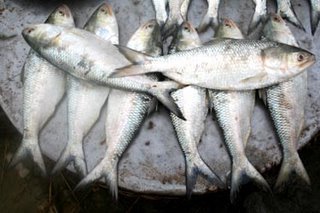
Boats on the Padma
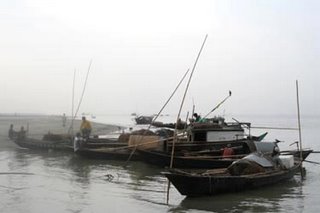
Dad feeding coconut-water to kid
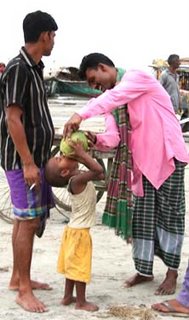
Man with suitcase and fish
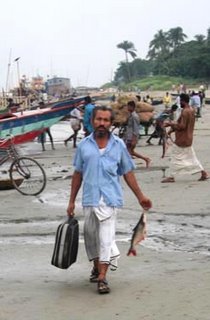
Boy who works on a boat

Windows in Mawa village

Girl with doll on riverbank

Cute kid at Mawa village

Entrance to JC Bose's home
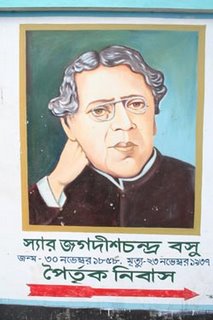
Compound of one building in JC Bose's home

Drying clothes on roof of JC Bose's home

Roof-antennas in the house where the man who invented wireless radio once lived:

Jarul flowers in another building in JC Bose home:
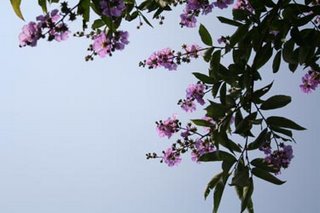
A hijol tree on the pond; hijol's decomposed bark is good fish food:

Old Zamindar mansion
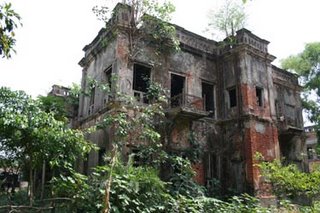
Pond belonging to Zamindar home
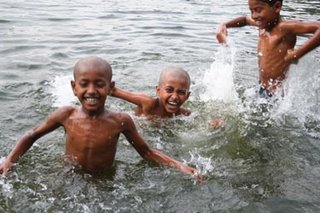
Kids climbed this tree for its flower

The Padma was wide even at this dry season. We found a fish-market on the sandy bank. Fish was brought in by numerous boats, and sold here for the markets in Dhaka. Children were playing everywhere. Mawa village lay next to the market, with narrow lanes and tin-roof houses.
From Mawa we drove to the ancestral home of (late) Sir Jagadish Chandra Bose - one of Indian subcontinent's most eminent scientists - in Dohar. Sir Bose invented wireless radio (local lore claims he divulged his findings to Marconi who walked off with the credits). He was also a great botanist, the first to prove conclusively that plants have lives.
Sir Bose's home is over many acres of land, and includes several buildings, ponds, orchards, etc. It has been converted into various schools and living quarters for school employees. Though there were statues and pictures of him, we found no documentation or introduction to his work. Sad.
From there we visited the old mansion of a (Hindu) Zaminder with directions from a local acquaintance. We found the palace to be in poor repair. Some remnants pointed to the glory of old days, including ancient broken water pumps that ran on diesel and pumped water up to a rooftop tank so the Zamindar family could take showers. I am not sure who owns the property now. In fact, I could not even find the name of the original Zaminder.
Then it was off to nearby Bhagyakul market where my companions tasted the famous local "maaTha" - a lemony, sweetened yogurt drink. I abstained for bacteriophobic reasons, but relented in the end. A sip of the drink was delicious, not as thick as Lassi, but made invigorating by fresh lemon juice.
We returned home by noon. Thanks to Dr. Zia for showing me these places. Now the pictures.
The Famous Hilsa Fish of the Padma

Boats on the Padma

Dad feeding coconut-water to kid

Man with suitcase and fish

Boy who works on a boat

Windows in Mawa village

Girl with doll on riverbank

Cute kid at Mawa village

Entrance to JC Bose's home

Compound of one building in JC Bose's home

Drying clothes on roof of JC Bose's home

Roof-antennas in the house where the man who invented wireless radio once lived:

Jarul flowers in another building in JC Bose home:

A hijol tree on the pond; hijol's decomposed bark is good fish food:

Old Zamindar mansion

Pond belonging to Zamindar home

Kids climbed this tree for its flower

Stories from DS Business Awards
I attended this Award ceremony tonight. A great service from the Daily Star, to recognize business leaders and inspire budding entrepreneurs.
Couple of stories I found inspiring:
Business Person of the Year was Mr. Fazlur Rahman, Chairman of City Group of Industries, which employs 10000 people in 18 industries. I heard a story about him. When he was 9 years old, Mr. Rahman, who comes from a poor family in old Dhaka, went to the local grocery store to buy a few ounces of cooking oil on credit (I guess the family was short on cash). When he was turned down, he came home and swore to his Mother, "One day I will make an oil factory." And sure enough, his first factory was an Oil Mill (today they make Teer Cooking Oil as well as a zillion other things.) What an inspiration!
The last 5 years in the US, with increasing outdoor activities such as camping, hiking, biking, etc I grew fond of outdoors wear. The North Face is my favorite brand among technical outdoor clothing, because of their high quality (strong, lightweight, quick-drying, insulating, etc.) And guess what, much of their high-performance clothing is made in Bangladesh. The factory is Youngone, a Korean-Bangladeshi company, which won an award tonight.
The reason I found Youngone so inspiring is because this is cutting-edge stuff they make, not me-too products. Their philosophy of specializing in one thing and becoming really good at it has really paid off. They have proved that Bangladesh can create products w-a-a-a-y up the value chain.
I believe such an approach will work for the local IT industry.
Couple of stories I found inspiring:
Business Person of the Year was Mr. Fazlur Rahman, Chairman of City Group of Industries, which employs 10000 people in 18 industries. I heard a story about him. When he was 9 years old, Mr. Rahman, who comes from a poor family in old Dhaka, went to the local grocery store to buy a few ounces of cooking oil on credit (I guess the family was short on cash). When he was turned down, he came home and swore to his Mother, "One day I will make an oil factory." And sure enough, his first factory was an Oil Mill (today they make Teer Cooking Oil as well as a zillion other things.) What an inspiration!
The last 5 years in the US, with increasing outdoor activities such as camping, hiking, biking, etc I grew fond of outdoors wear. The North Face is my favorite brand among technical outdoor clothing, because of their high quality (strong, lightweight, quick-drying, insulating, etc.) And guess what, much of their high-performance clothing is made in Bangladesh. The factory is Youngone, a Korean-Bangladeshi company, which won an award tonight.
The reason I found Youngone so inspiring is because this is cutting-edge stuff they make, not me-too products. Their philosophy of specializing in one thing and becoming really good at it has really paid off. They have proved that Bangladesh can create products w-a-a-a-y up the value chain.
I believe such an approach will work for the local IT industry.
Wednesday, May 03, 2006
My Letter in Time Magazine
Time magazine (Asia edition) on May 8, 2006 published my letter (in its entirety) regarding the Bangladesh article.
I can't find a link, so I will just quote the email I sent them.
Dear Sir,
Natives of Bangladesh, me and my wife worked in Silicon Valley for over 20 years in both engineering and managerial roles before deciding to return here in 2005. A key factor that helped us decide was the growth of the economy. Time-Asia's April 3rd cover story validates our thinking.
However, your story placed too little emphasis on the entrepreneurs and the development visionaries and too much emphasis on the politicians.
Too often, the progress of Bangladesh has been because of the efforts of the former and *despite* the efforts and petty bickerings of the latter.
Ihtisham Kabir
I can't find a link, so I will just quote the email I sent them.
Dear Sir,
Natives of Bangladesh, me and my wife worked in Silicon Valley for over 20 years in both engineering and managerial roles before deciding to return here in 2005. A key factor that helped us decide was the growth of the economy. Time-Asia's April 3rd cover story validates our thinking.
However, your story placed too little emphasis on the entrepreneurs and the development visionaries and too much emphasis on the politicians.
Too often, the progress of Bangladesh has been because of the efforts of the former and *despite* the efforts and petty bickerings of the latter.
Ihtisham Kabir
Subscribe to:
Posts (Atom)








